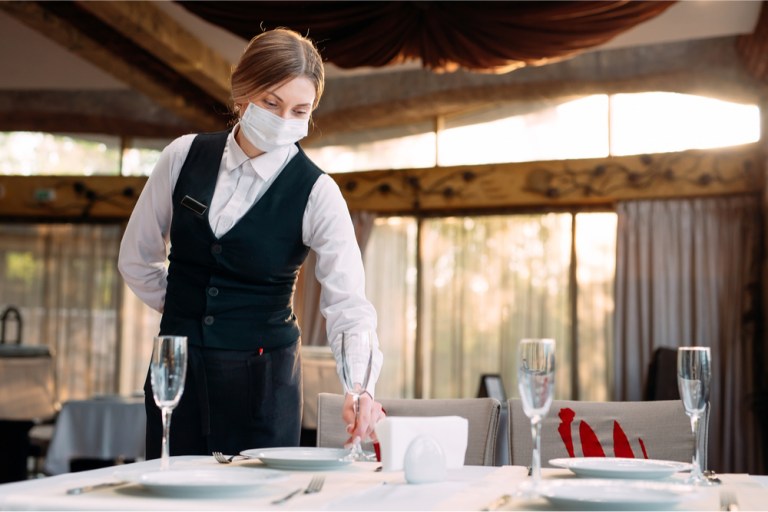Is Dining Out At Risk Of Dying Out, At Least For The Time Being?

The future of dining out is looking increasingly dark these days. The ranks of high-profile restaurateurs announcing that their grand reopening will be greatly delayed seems to be swelling by the week.
The latest edition to the roster comes from Danny Meyer, founder and CEO of Union Square Hospitality Group. Meyer just announced that he doesn’t see reopening the dining rooms of his 19 restaurants across New York City until there’s a coronavirus vaccine.
The restaurateur told Bloomberg that he doesn’t see operating a half-full dining room of guests who need to have their temperatures taken before they can be seated. Nor does he foresee workers making very little money, submitting to temperature checks of their own and wearing masks for their whole shifts.
“We won’t be welcoming guests into our full-service restaurants for a very long time — probably not until there’s a vaccine,” Meyer said. “It’s very frustrating, but it’s the only safe way to go.”
He joins Swiss chef Daniel Humm, owner of Manhattan’s Eleven Madison Park, who said he might not reopen ever. Washington, D.C. chef and restaurant group owner David Chang has likewise permanently shuttered Nishi in Chelsea and Momofuku in Washington.
And Chicago-based restaurant owner Abe Conlon, a James Beard Award-winning chef, is transforming his Fat Rice restaurant into the Fat Rice Market, an experimental model that’s something like a convenience store for foodies.
“The restaurant for the foreseeable future is dead,” Conlon said. “We need to face the reality that we can’t exist in the future as it looks now. People are not going to feel comfortable being in close quarters or being in a cramped dining room.”
That’s a sentiment that is notably reflected in PYMNTS’ recent consumer surveys on life during lockdown — and the public’s expectations for what comes next.
That consumers miss dining out is by the numbers undeniable. Of things that consumers told us they’re most looking forward to, eating out in restaurants was the second most common reason cited for a desire to get out.
Some 53 percent of respondents listed that as their first, second or third choice for leaving the house — the No. 3 choice overall of those we surveyed. Only seeing friends and family and going back to work edged out eating out as consumers’ top priority for being ready to return to the world.
Moreover, when the U.S. government stimulus checks began to roll out, buying prepared food captured a fair portion of the spend generated by the funds. Roughly 16 percent of those who received stimulus dollars had expended some of them to purchase food (usually in takeout form) from restaurants within a day or two.
But the fact that consumers are literally hungering for a return to restaurant dining doesn’t mean that they’re in a rush to get back to dining rooms. Especially considering, as Karen Webster noted in a recent commentary, that likely new standard restaurant operating procedures don’t exactly sound appetizing.
The waitstaff will certainly have to wear masks, as will perhaps those dining out (except for they must remove them to actually put food in their mouths). Temperatures will be scanned at the door, capacities will be limited and reservations may well be a thing of the past. Restaurants attempting to manage efficiently to capacity as possible will likely move to a first-come, first-served system.
On top of that, there will likely be no more sitting at the bar and no more metal cutlery, as disposable plastic seems safer. You might even have to sign a statement at the door saying that you’re not sick. Yum!
“The experience feels weird, even awkward, for everyone. If that’s the restaurant experience for the next several months, will consumers go at all — or as much as they used to?” Webster asked, noting that eating out is as much about the social experience as the food.
And even if consumers are willing to go along for the ride and try to adapt their behavior, restaurants will have to change as well, CaliGroup CEO John Miller told Karen Webster in a recent conversation.
CaliGroup uses technology to transform the restaurant and retail industries. Among the company’s best-known holdings are quick-service restaurant (QSR) chain CaliBurger; ghost kitchen company Kitchen United; and Miso Robotics, which uses robots to prepare food.
CaliGroup’s PopID Face Pay product normally does digital-face scanning for payment. But the company has expanded the device’s role by adding computer vision and heat-sensor technology to do contactless temperature screenings for restaurant staff and diners.
Miller told Karen Webster that restaurants of all kinds are going to have to start thinking very differently about how they’re going to offer service. After all, what’s happening now doesn’t represent a temporary blip so much as a massive sea change that could easily stretch out as much as two years. Basing one’s core business around a half-empty dining room, he noted, won’t cut it.
“I think the biggest problem is that if you can’t bring as many people into the dining room, the unit economics just aren’t going work,” he said. “And a lot of places in expensive retail locations, they just can’t hit the top line.”
Consumers still want to eat prepared foods — the data reflect that in many ways. But Miller said there are going to be a lot of pivots to meet the demand of consumers newly accustomed to ordering meals, picking them up or having them delivered and “eating out” at home.
That might be in the form of moves to ghost kitchens, gourmet convenience shops or specialty meal kits. For now, what seems clear is that restaurants hoping to resume business in a post COVID-19 world will have to do lot of moving around.